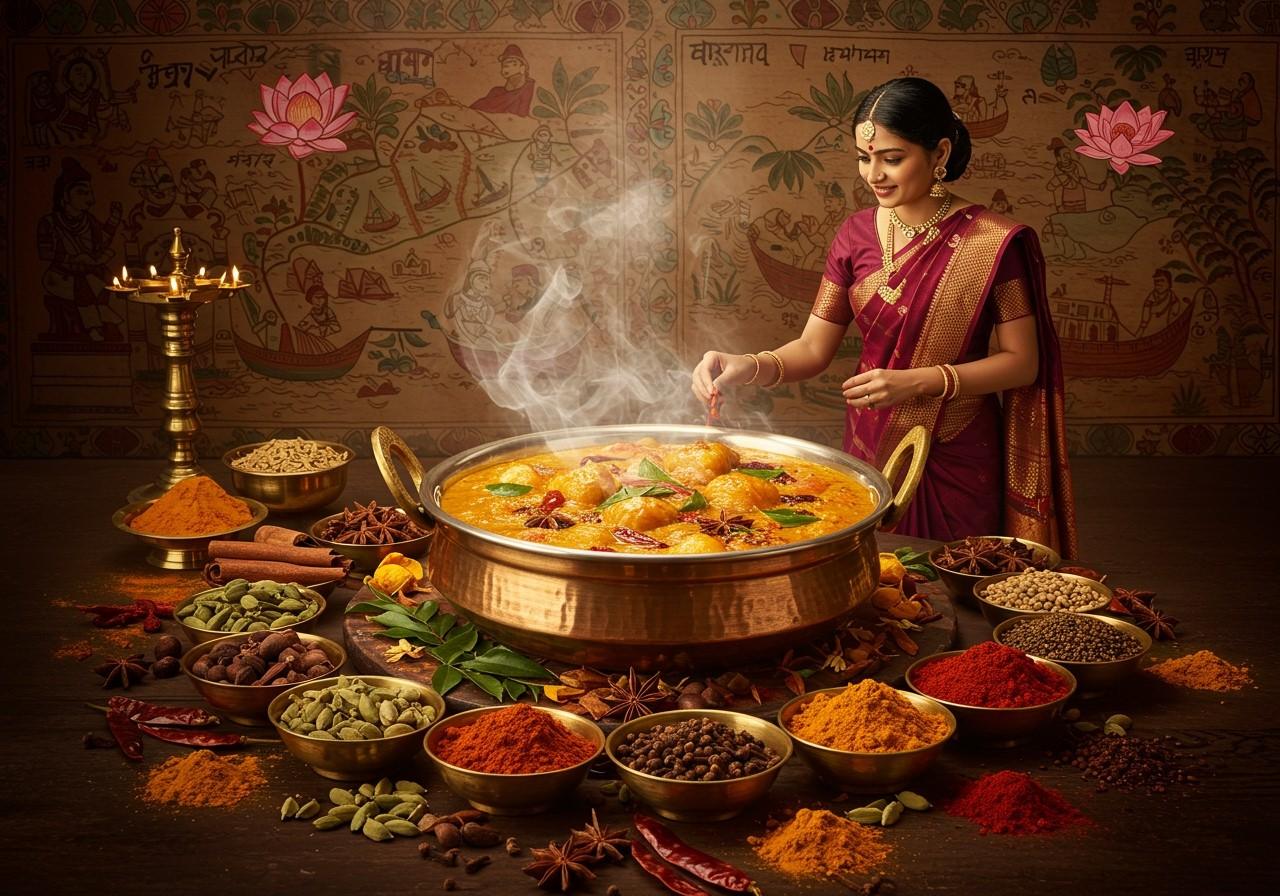
Curry, a culinary marvel, boasts a rich and intricate history deeply intertwined with India’s diverse culinary heritage. More than just a dish, it embodies cultural legacy, cherished family recipes, and the essence of Indian hospitality. This exploration delves into the captivating story of curry, offering insights into its significance and evolution across the globe.
The Origins and Etymology of Curry
The roots of curry can be traced back to the Indus Valley Civilization around 2500 BCE. Archaeological discoveries of spice remnants in ancient cooking vessels reveal the use of turmeric, ginger, and garlic, indicating the early presence of curry-like preparations. Over centuries, influential dynasties such as the Mauryas and Guptas, along with Ayurvedic practices, shaped the evolution of curry recipes. The Silk Road and other trade routes introduced new spices to India, further enriching the flavors of this iconic dish. Did you know that the term “curry” itself is derived from the Tamil word “kari,” meaning sauce or gravy? British colonists adopted and adapted this term in the 17th century. Interestingly, curry is known by various names across different regions of India, such as “jhol” in Bengal and “rasam” in Tamil Nadu.
Curry’s Global Journey
While curry originated in India, its influence has spread far and wide, resulting in diverse interpretations across South Asia and beyond. Countries like Pakistan, Bangladesh, and Sri Lanka have developed their own unique versions of curry. The Indian diaspora played a significant role in popularizing curry globally, particularly in the UK, Japan, and Southeast Asia. It’s important to note that Indian curries differ from those in Thailand and Malaysia, primarily in terms of ingredients and preparation methods. European colonialism, particularly by the Portuguese, Dutch, and British, further propelled curry’s international spread, leading to the creation of fusion dishes in regions like the Caribbean and Africa.
Regional Variations within India
India’s diverse culinary landscape is reflected in the regional variations of curry. Each state boasts its own distinct style, showcasing the country’s rich gastronomic tapestry.
- South Indian Curries: Known for their generous use of coconut milk, creating rich and creamy textures. These curries often feature tamarind for a tangy twist and incorporate a blend of spices that create a harmonious balance of flavors. You can read more about South Indian culture here.
- North Indian Curries: Characterized by the use of dairy products like yogurt and cream, resulting in a milder and richer flavor profile. These curries often incorporate tomatoes for a tangy base and utilize a variety of aromatic spices. Explore more about Sun Temples, which are prominent in North India, in this article.
- Spice Blends: Each region has its signature spice blend, contributing to the unique character of its curries. Garam masala is prevalent in the North, panch phoron in Bengal, and sambar powder in Tamil Nadu. These blends are carefully crafted to enhance the flavor profiles of the dishes, reflecting the distinct culinary traditions of each area.
Popular regional dishes include Rogan Josh from Kashmir, Vindaloo from Goa, and Chettinad Chicken from Tamil Nadu. The use of local ingredients and the influence of climate contribute to the unique flavor profiles of these curries.
Cultural Significance and Global Recognition
Curry holds a prominent place in Indian festivals and rituals, with special dishes prepared during celebrations like Diwali and Holi. Recipes are often passed down through generations, preserving family traditions and regional heritage. Curry is an integral part of everyday meals, embodying the essence of Indian culture and hospitality. India’s love for curry is evident in its literature, cinema, and music, symbolizing warmth, togetherness, and celebration. Sharing a meal centered around curry strengthens bonds between family and friends.
Curry’s global journey has made it a symbol of Indian cuisine worldwide. From British tikka masala to Japanese kare raisu, each region has adapted curry while respecting its original essence. Colonialism, particularly through the Portuguese introduction of chili peppers and the British popularization of curry in their colonies, played a crucial role in its global spread. This exchange of ingredients and culinary ideas has led to the creation of fusion dishes enjoyed worldwide. Learn more about the architectural marvels of India’s Sun Temples here.
Preserving Tradition and Embracing Flavors
In today’s fast-paced world, preserving traditional curry recipes is paramount. Using authentic ingredients, such as freshly ground spices, ensures the true flavors shine through. Online platforms like poojn.in offer convenient access to high-quality ingredients without compromising on authenticity. Exploring diverse curry recipes allows us to appreciate India’s rich culinary heritage, reminding us that food is not just sustenance but a way to honor our roots and share our history.
Get Authentic Spices at Poojn.in
Poojn.in provides a wide selection of premium, pure turmeric (haldi) and other essential spices for crafting traditional Indian curries. Our turmeric powder is sourced from carefully selected suppliers, ensuring authentic properties and purity suitable for both culinary and religious purposes. We offer organic turmeric powder, rich in curcumin, and a comprehensive collection of curry essentials like coriander, cumin, red chili, and garam masala. Visit Poojn.in to explore our complete range of pure spices and pooja items, conveniently available for online ordering with reliable delivery across India.
Conclusion
Curry is more than just a dish; it represents India’s vibrant culture, history, and culinary diversity. From its ancient beginnings to its global presence, curry has evolved while staying true to its roots. By embracing authentic ingredients and traditional recipes, we keep the essence of Indian cuisine alive. Curry’s journey is a testament to the warmth, hospitality, and rich heritage of Indian culture. So, next time you savor a bowl of curry, remember its remarkable history and the joy it brings.


